Necrotic Skin Lesions: Spider Bite-or Something Else?
The bites of only a few spider species produce medically significant effects in humans.
Patients often attribute the otherwise unexplained development of a dermonecrotic lesion to a spider bite. This self-diagnosis is rarely corroborated by evidence, however. The spider is seldom seen by the patient, let alone recovered for identification, and the bite is often not felt.
Although spider bites can produce dermonecrotic wounds, the differential diagnosis of such lesions is extensive. Most of the conditions in the differential are far more common than spider bites. Thus, we suggest that you approach the complaint of a "spider bite" with a skeptical eye.
Here we describe the clinical features of spider bites and summarize the treatment options. We also examine the reasons why the diagnosis of "spider bite" remains a popular explanation for any unexplained dermonecrotic lesion, and we review the conditions in the differential diagnosis of such lesions.
SPIDER BITES: AN OVERVIEW
Spiders have complex and specialized feeding strategies; they often use webs to capture and eat insects and other small arthropods. Unlike insects that feed on human blood or serum, spiders have no reason to bite humans. Thus, a spider bite must be considered an anomaly that probably resulted from human actions which induced the arthropod to bite in self-defense.
In most cases, the medical consequences of a spider bite are minor. Typically, the bite causes limited local tissue inflammation similar to the bites and stings of other small arthropods, and patients respond well to over-the-counter analgesics and antihistamines, if any treatment is needed. Systemic effects, if they occur, are typically mild.
The bites of only a few spider species produce medically significant effects in humans. In the United States, the brown recluse (Figure 1) and the black widow (Figure 2) are the 2 best-known species that can cause serious illness.
Brown recluse spider. The brown recluse spider (Loxosceles reclusa) is endemic in the south central states, from Texas to the Carolinas, and as far north as Iowa and Illinois (Figure 3).1 Other Loxosceles species in the Southwest cause fewer reported bites, and their envenomations are typically less severe.
The brown recluse spider is tan to brown and has a darker mark on the dorsal cephalothorax that resembles a violin; hence, its other common names, violin spider and fiddleback. As its name implies, the brown recluse spider dwells in low-traffic areas, such as attics, basements, and woodpiles. In states where the spider is endemic, hundreds or even thousands of brown recluse spiders may be found in a single home, yet no one in the household has been bitten.2
Clinical features. Patients who have been bitten by a brown recluse spider may report a pinprick sensation, although the bite may be painless. Bites most commonly occur when a person disturbs a spider after he or she puts on clothes that were left on the floor or rolls over in bed onto the arthropod. Brown recluse spiders are nonaggressive toward humans; however, when they feel threatened, they may bite in self-defense.
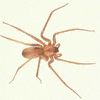
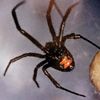

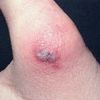
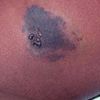
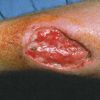
The local inflammation and tissue necrosis associated with brown recluse spider bites results from the spider's venom, which contains enzymes and other products. Within 2 to 6 hours, the bite site becomes pruritic and burning pain, erythema, and swelling develop (Figure 4). Over the next several hours or days, a hemorrhagic vesicle appears and then ulcerates. Progression of the lesion results in a central bluish necrotic depression within surrounding erythema. A blanched ring may form around the necrotic area because of local vasoconstriction, giving the entire lesion a "red, white, and blue" appearance (Figure 5). The necrotic area then forms an eschar, which can take several weeks or months to heal (Figure 6).
Systemic signs and symptoms-such as arthralgia, rash, fever, vomiting, and hemolysis-are rare (between 0.7% and 1.8% of reported bites). The incidence of systemic loxoscelism is higher in children, perhaps because of the greater amount of venom injected per kilogram of body weight than in adults.
Management. Brown recluse spider bites have been treated with antibiotics, antihistamines, corticosteroids, dapsone, hyperbaric oxygen, nitroglycerine patches, surgical excision, and even direct high-voltage current from a stun gun. Few of these treatments have been tested, and none have proved beneficial.3,4 In most cases, the lesions heal with standard local wound care. Because the initial lesion results from envenomation rather than a bacterial infection, empiric antibiotic therapy is inappropriate. However, consider antibiotic therapy if you suspect a secondary infection of the lesion.
Black widow spider. Several Latrodectus species in North America are known as black widow spiders, although their native territories have considerable overlap. Latrodectus hesperus is primarily found in the West, Latrodectus mactans in the Southeast, and Latrodectus variolus in the Northeast. Unless one is close enough to observe the small differences in the shape of the red or red-orange mark on the ventral abdomen, these spiders are essentially identical and may be considered together as a group. L hesperus has the most characteristic hourglass-shaped mark, L mactans has an anvil-shaped mark, and L variolus has 2 red blobs.
Black widow spiders are found typically in garages, barns, sheds, and woodpiles and on outdoor furniture and classically in outhouses. Female black widow spiders have shiny, black, globular bodies about 1 cm in diameter. They are usually seen hanging ventral side-up from their webs. Male black widow spiders, which are a fraction of the size of their female counterparts, have smaller fangs that cannot penetrate human skin.
Common popular myth holds that female black widow spiders always consume the male spiders after mating. This behavior has been observed more commonly in laboratory conditions than in the wild; thus, it may be stress-induced, and its incidence varies between species within the Latrodectus genus.
Clinical features. Persons who are bitten by a black widow spider may feel a sharp pinprick or nothing at all. The a-latrotoxin in the venom causes uncontrolled release of acetylcholine and norepinephrine neurotransmitters from presynaptic sites, resulting in painful muscle cramping and signs of adrenergic excess.
Patients often complain of moderate to severe pain that spreads from the bite area and may become generalized.5,6 Bites on the arm or neck may thus present with chest pain; those on the leg or perineum may present with back or lower abdominal pain. Because of the involuntary muscular spasm, diaphoresis, and hypertension associated with severe envenomations, black widow bites can be mistaken for an acute abdomen or myocardial infarction.7
Classically, a target lesion appears at the site of a black widow spider bite that consists of a small patch of pallor (about the size of a dime [approximately 15 mm]), caused by intense local vasoconstriction, surrounded by a rim of erythema.6 One or 2 puncture marks may be seen in the center of the lesion.
The signs and symptoms of black widow spider envenomation typically wax and wane over 24 to 48 hours. During this time, clinicians can mistakenly assume that their interventions were successful, when in fact the patient’s symptoms resolved on their own.5 Prematurely discharged patients who are given an inadequate supply of analgesics often return for evaluation when their symptoms recur. In some cases, symptoms can last several days.8 Although black widow spider bites can be painful and distressing, death is exceedingly rare.
Management. Patients who present with black widow spider bites may be treated with supportive and symptomatic care. Intravenous opiate analgesia, with or without benzodiazepines, is usually sufficient. In a study of 163 patients, intravenous calcium gluconate showed no benefit.6
Treatment of systemic latrodectism with black widow spider antivenin remains controversial. The currently available antivenin greatly shortens the duration of symptoms and prevents their recurrence; however, it is associated with a small risk of allergic reactions.6 In the United States, the last reported death related to black widow spider envenomation resulted from anaphylaxis to the antivenin. In this case, the patient had a history of significant obstructive pulmonary disease, which is generally considered a contraindication to serotherapy.9
Although inherently no more dangerous than other commonly used horse serum-derived antivenins (eg, Crotaline snake antivenin), the black widow spider antivenin has been used infrequently in the United States over the past several years, probably because of concerns about its safety profile. The decision to use black widow spider antivenin hinges on your assessment of the therapy’s potential benefit and risks as well as the severity of the patient’s illness.
WHY MISDIAGNOSIS PERSISTS
At least 3 reasons account for the persistent misdiagnosis of unexplained lesions as spider bites by many patients and some health care professionals:
• Arachnophobia is a common fear. It is easy, and perhaps oddly comforting, to ascribe unexplained and potentially frightening symptoms to spider bites. In the United States, the spider most commonly implicated as the cause of dermonecrotic lesions is the brown recluse (Box).10-13
• Patients often have difficulty in accepting that a medical problem has an endogenous origin. They prefer to blame an external agent, such as a poison or envenomation.
• Some health care professionals may find it easier to rely on the diagnosis of "spider bite" than to generate an adequate differential diagnosis for a skin lesion of unknown origin.
DIFFERENTIAL DIAGNOSIS
Although spider bites can produce dermonecrotic wounds, the differential diagnosis of such lesions is extensive; it includes microbial infections, dermatologic disorders, vasculitides, and environmental exposures (Table).14-16
We use the term "idiopathic dermonecrotic skin lesion" for lesions ascribed to spider bites that defy easy diagnosis. Empiric antibiotic therapy is often indicated because many of these lesions are, in fact, caused by bacterial infection.15,16Patients whose condition does not improve with this treatment, or whose lesions are not consistent with infection, may require further workup. Dermatology referral may be indicated in some cases.
Bacterial cellulitis. Most patients with alleged spider bites have bacterial cellulitis, which is often caused by community-acquired methicillin-resistant Staphylococcus aureus (CA-MRSA).17-21 This bacterium is an emerging cause of skin and soft issue infections worldwide.
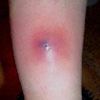
Click to Enlarge
The classic CA-MRSA lesion appears as an area of cellulitis around a darker purpuric center with overlying dermonecrosis (Figure 7). The central necrosis of the CA-MRSA lesion, unlike that of the brown recluse spider bite, is usually slightly raised from the surrounding skin, because of edema or an underlying abscess. Patients with a CA-MRSA infection who claim to have a spider bite rarely report feeling a bite or seeing a spider and often admit that a friend or family member suggested this was the cause.
CA-MRSA strains are generally resistant to the b-lactam drugs (eg, oral cephalexin) used to treat skin and soft tissue infections. Effective antibiotic choices for CA-MRSA include vancomycin, daptomycin, tigecycline, and linezolid, when intravenous administration is indicated, or clindamycin, doxycycline, linezolid, minocycline, and trimethoprim/sulfamethoxazole (TMP/SMX), when oral therapy will suffice.22
Many of these drugs choices are rather expensive. In our experience, most patients with these lesions-frequently, parenteral drug abusers and recent prison inmates and their close contacts--have very limited financial resources. Fortunately, nearly all CA-MRSA strains reported to date are susceptible to TMP/SMX and clindamycin, which are relatively inexpensive options. Clindamycin, however, is not used as empiric monotherapy because many strains have inducible clindamycin resistance.
When outpatient oral therapy is deemed adequate, we treat presumed CA-MRSA infection with 2 drugs: TMP/SMX (1 double-strength tablet twice daily) and either clindamycin (300 mg 4 times daily) or doxycycline (100 mg bid). Treatment duration is 7 to 10 days, and generic formulations can be prescribed to reduce costs. Incision and drainage of any concurrent abscesses is also indicated.
EXNOERATING THE OFT-ACCUSED BROWN RECLUSE
The brown recluse-the spider most commonly implicated in alleged bites-lives and breeds predominantly in the south central United States. Yet complaints of brown recluse spider bites are ubiquitous.10-12 In one study, a total of 216 cases of brown recluse spider bites were diagnosed in California, Oregon, Washington, and Colorado during a 41-month period, yet only 17 Loxosceles reclusa specimens have ever been verified in these states.10 Because public reporting of spider bite diagnoses is not required, the number of misdiagnoses noted in this study is likely a gross underestimate of the actual total.
When confronted with evidence of geographic improbability, patients with an alleged brown recluse spider bite commonly respond that the spider was recently imported from an area where it is endemic.13 In California, a common assumption is that the bite was caused by a cousin of the brown recluse spider (Loxosceles deserta). Maps of the number of reported spider bite cases in the United States indicate that the highest number of cases are in the most densely populated areas, irrespective of the spider's confirmed habitat.10 These data suggest that the larger the population of a given area, the higher the incidence of dermo-necrotic lesions of unknown origin, which may be attributed to spider bites.
CLINICAL HIGHLIGHTS
• Persons who have been bitten by a brown recluse spider have pruritus, burning pain, erythema, and swelling at the bite site within 2 to 6 hours. Over the next several hours or days, a hemorrhagic vesicle appears that ulcerates. Progression of the lesion results in a central bluish necrotic depression with surrounding erythema.
• Treat brown recluse spider bites with standard local wound care. Consider antibiotic therapy only if secondary infection develops.
• The classic lesion that appears after a black widow spider bite consists of a small pallid area surrounded by a rim of erythema. Associated pain can be severe. The signs and symptoms of black widow spider envenomation typically wax and wane over 24 to 48 hours and can last several days.
• For patients with black widow spider bites, intravenous opiate analgesia, with or without benzodiazepines, is usually sufficient. Antivenin greatly shortens the duration of symptoms and prevents their recurrence; however, it is associated with a risk of allergic reactions.
• Consider empiric antibiotic therapy for idiopathic dermonecrotic skin lesions because many of these lesions are caused by bacterial infection. If the patient’s condition does not respond to antibiotics, further workup or referral to a dermatologist may be warranted.
Spider Bites, Spider MythsCan You Identify These Pathogenic Organisms That Creep, Float, or Fly?
Dermclinic: Brown Recluse Spider BiteTreating Spider Bites: Is Dapsone an Option?Is This the Bite of a Recluse or Hobo?Brown Recluse Spider Bite
References:
REFERENCES:1.Swanson DL, Vetter RS. Bites of brown recluse spiders and suspected necrotic arachnidism. N Engl J Med. 2005;352:700-707.
2.Vetter RS, Barger DK. An infestation of 2,055 brown recluse spiders (Araneae: Sicariidae) and no envenomations in a Kansas home: implications for bite diagnoses in nonendemic areas. J Med Entomol. 2002;39:948-951.
3.Hogan CJ, Barbaro KC, Winkel K. Loxoscelism: old obstacles, new directions. Ann Emerg Med. 2004; 44:608-624.
4.Cacy J, Mold JW. The clinical characteristics of brown recluse spider bites treated by family physicians: an OKPRN Study. Oklahoma Physicians Research Network. J Fam Pract. 1999;48:536-542.
5.Saucier JR. Arachnid envenomation. Emerg Med Clin North Am. 2004;22:405-422.
6.Clark R, Wethern-Kestner S, Vance M, Gerkin R. Clinical presentation and treatment of black widow spider envenomation: a review of 163 cases. Ann Emerg Med. 1992;21:782-787.
7.Bush SP. Black widow spider envenomation mimicking cholecystitis. Am J Emerg Med. 1999;17:315.
8.O'Malley GF, Dart RC, Kuffner EF. Successful treatment of latrodectism with antivenin after 90 hours. N Engl J Med. 1999;340:657.
9.Clark RF. The safety and efficacy of antivenin Latrodectus mactans. J Toxicol Clin Toxicol. 2001;39: 125-127.
10.Vetter RS, Cushing PE, Crawford RL, Royce LA. Diagnoses of brown recluse spider bites (loxoscelism) greatly outnumber actual verifications of the spider in four western American states. Toxicon. 2003;42:413-418.
11.Vetter RS, Bush SP. Reports of presumptive brown recluse spider bites reinforce improbable diagnosis in regions of North America where the spider is not endemic. Clin Infect Dis. 2002;35: 442-445.
12.Vetter RS, Edwards GB, James LF. Reports of envenomation by brown recluse spiders (Araneae: Sicariidae) outnumber verifications of Loxosceles spiders in Florida. J Med Entomol. 2004;41:593-597.
13.Suchard JR. Diagnosis and treatment of cutaneous anthrax. JAMA. 2002;288:43.
14.Isbister GK. Necrotic arachnidism: the mythology of a modern plague. Lancet. 2004;364:549-553.
15.Cacy J, Mold JW. The clinical characteristics of brown recluse spider bites treated by family physicians: an OKPRN study. Oklahoma Physicians Research Network. J Fam Pract. 1999;48:536-542.
16.Wright SW, Wrenn KD, Murray L, Seger D. Clinical presentation and outcome of brown recluse spider bite. Ann Emerg Med. 1997;30:28-32.
17.Frazee BW. Images in emergency medicine. Forearm furuncle resulting from community-associated methicillin-resistant Staphylococcus aureus (MRSA). Ann Emerg Med. 2005;45:244, 250.
18.Centers for Disease Control and Prevention. Public health dispatch: outbreaks of community- associated methicillin-resistant Staphylococcus aureus skin infections--Los Angeles County, California, 2002-2003. MMWR. 2003;52:88.
19.Fagan SP, Berger DH, Rahwan K, Awad SS. Spider bites presenting with methicillin-resistant Staphylococcus aureus soft tissue infection require early aggressive treatment. Surg Infect. 2003;4: 311-315.
20.Centers for Disease Control and Prevention. Resistant Staphylococcus aureus infections in correctional facilities--Georgia, California, and Texas, 2001-2003. MMWR. 2003;52:992-996.
21.Dominguez TJ. It's not a spider bite, it's community-acquired methicillin-resistant Staphylococcus aureus. J Am Board Fam Pract. 2004;17:220-226.
22. Treatment of community-associated MRSA infections. Med Lett. February 13, 2006:48(1227):13-14.
RELEVANT REVIEW
Swanson DL, Vetter RS. Bites of brown recluse spiders and suspected necrotic arachnidism. N Engl J Med. 2005;352:700-707.